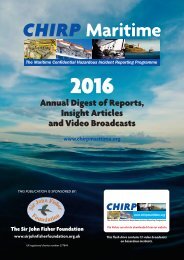CHIRP annual digest 2016 6th
Create successful ePaper yourself
Turn your PDF publications into a flip-book with our unique Google optimized e-Paper software.
<strong>CHIRP</strong> Annual Digest <strong>2016</strong><br />
happy that our safety culture is working … the positive<br />
reaction to this incident was that we worked as a team,<br />
procedures were used, and no dangerous situation<br />
occurred’.<br />
The lessons to be learnt<br />
Notwithstanding the discrepancy between the report<br />
and the company’s comment, this case provides the<br />
opportunity to air this vital issue.<br />
Enclosed spaces are the 2nd biggest killer at sea.<br />
Consequently the correct safety precautions are widely<br />
discussed. They are comprehensively described in the<br />
UK’s COSWPs for Seafarers, and they feature in the<br />
IMO’s SOLAS framework. From 1 January 2015, bimonthly<br />
entry and rescue drills became mandatory. In<br />
addition remote testing equipment is mandatory<br />
onboard ships from July <strong>2016</strong>.<br />
The <strong>CHIRP</strong> Maritime Advisory Board’s conclusions on<br />
this latest case emphasised the following points: ‘If in<br />
doubt, treat a space as enclosed’; for example the<br />
existence of a gooseneck vent on a water tank does not<br />
mean it is not ‘enclosed’. Nor is a space that is partially<br />
open necessarily safe. A crew member can be overcome<br />
in seconds. A meter around his or her neck will not<br />
necessarily prevent death, if the atmosphere ceases to<br />
have the required concentration of oxygen or contains<br />
toxic gases. Once again, ship’s robust safety culture is<br />
crucial. Competence, training and experience comple -<br />
ment Safe Systems of Work, Permits to Work and risk<br />
assessments. Regular emergency exercises for confined<br />
space entry and rescue drills are vital in good safety<br />
management systems and practice. Beware of com -<br />
placency; it leads to dangerous practices. Departmental<br />
briefings and debriefings, senior leadership by example,<br />
and consistent use of language (as in the word<br />
‘enclosed’) are all important in building a good safety<br />
culture”.<br />
An enclosed space is one that:<br />
IMO Resolution A1050(27): has limited openings<br />
for entry and exit; has inadequate ventilation; and<br />
is not designed for continuous worker occupation<br />
<strong>CHIRP</strong> Suggests<br />
Can you ‘Walk the Talk?’ Double-check procedures.<br />
Practice regularly. Lead by example. Make sure everyone<br />
onboard knows this is the second biggest killer at sea.<br />
The above article was published in MFB42<br />
Article. 03<br />
‘Don’t Get Wet Feet’ – Embarkation<br />
and Disembarkation Risks<br />
A major charterer and ship manager has reviewed<br />
incidents involving injuries while embarking/disembarking<br />
ships. Three are shared here; most of us will have seen near<br />
misses like this in the past.<br />
■ Disembarking from a vessel to a boat alongside, using<br />
the ship’s accommodation ladder; the person re -<br />
portedly lost his balance while stepping on to the<br />
boat, and fell into the water.<br />
■ Descending the vertical jetty ladder to board a barge,<br />
a cargo surveyor lost his grip, hit the deck of the barge<br />
and fell into the water. He suffered a broken knee, and<br />
injuries to his leg and head. The surveyor was carrying<br />
sampling bottles in his jacket.<br />
■ While boarding a vessel using the ship’s accom -<br />
modation ladder, the boat engaged in the transfer<br />
operation rose with the swell causing the person to<br />
be hit by the ship’s ladder. The person suffered a<br />
fracture to his leg.<br />
<strong>CHIRP</strong> Suggests<br />
■ Guidelines for some of these operations, as well as<br />
the equipment in use, are available. KNOW THE<br />
EQUIP MENT, KNOW AND OBSERVE THE GUIDE-<br />
LINES.<br />
■ Scenarios, equipment and environmental conditions<br />
vary. PAY ATTENTION; KEEP ALERT. This applies to<br />
both those that transfer and those that supervise the<br />
activity.<br />
■ DON’T TRANSFER, OR ALLOW TRANSFER, UNLESS IT<br />
LOOKS AND FEELS RIGHT. INTERVENE IF NEEDED.<br />
Article. 04<br />
Safely Moored?<br />
The above article was published in MFB42<br />
A passenger ship was berthed close to the stern of another<br />
vessel. As the passenger ship cleared the berth on de parture,<br />
the distance between the sterns of the two vessels reduced<br />
to 20 metres. The other vessel (pictured) had crew standing<br />
by to tend ropes if required. As shown below, they were in<br />
extremely hazardous positions. Fortunately, nothing went<br />
wrong; but the combination of poor design, berths ill<br />
matched to ships and snapback hazards can be lethal.<br />
What did the reporter tell us?<br />
The moored vessel does not fit the berth since stern lines<br />
cannot be run and the back spring and breast lines have<br />
8



